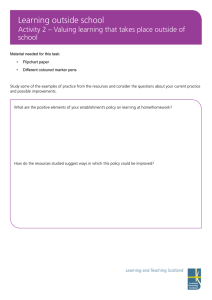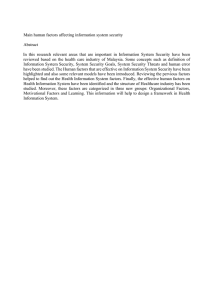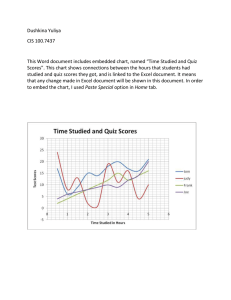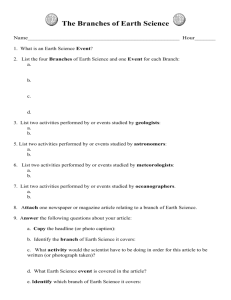Does the Number of Hours Studied Affect Exam Performance?
advertisement
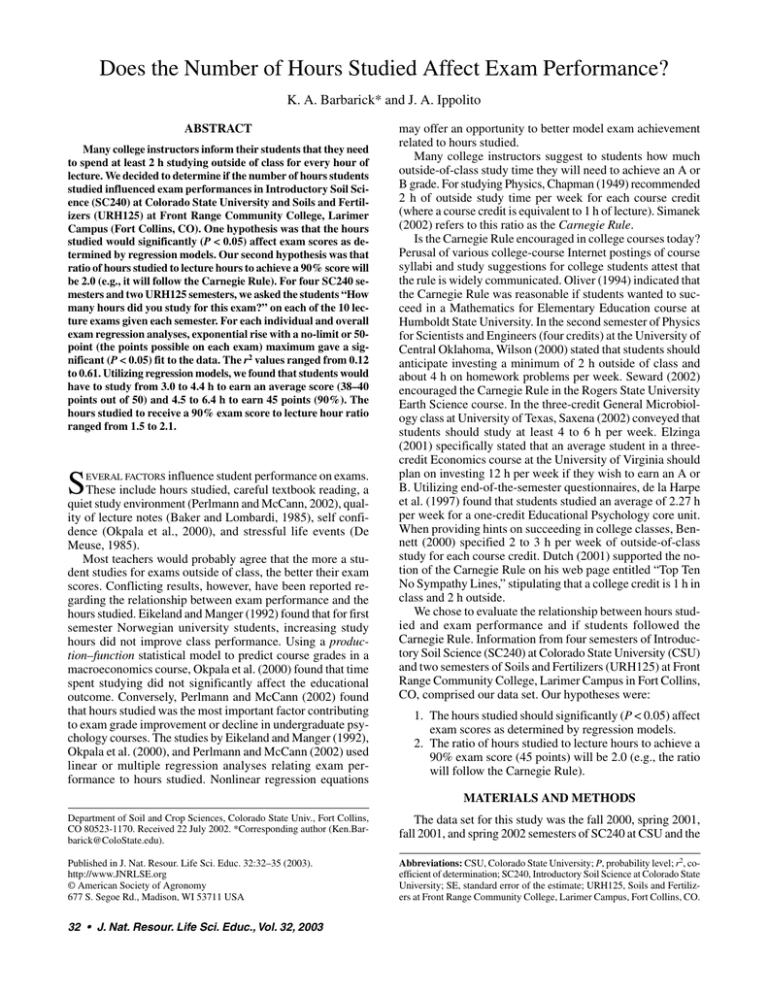
Does the Number of Hours Studied Affect Exam Performance?
K. A. Barbarick* and J. A. Ippolito
ABSTRACT
Many college instructors inform their students that they need
to spend at least 2 h studying outside of class for every hour of
lecture. We decided to determine if the number of hours students
studied influenced exam performances in Introductory Soil Science (SC240) at Colorado State University and Soils and Fertilizers (URH125) at Front Range Community College, Larimer
Campus (Fort Collins, CO). One hypothesis was that the hours
studied would significantly (P < 0.05) affect exam scores as determined by regression models. Our second hypothesis was that
ratio of hours studied to lecture hours to achieve a 90% score will
be 2.0 (e.g., it will follow the Carnegie Rule). For four SC240 semesters and two URH125 semesters, we asked the students “How
many hours did you study for this exam?” on each of the 10 lecture exams given each semester. For each individual and overall
exam regression analyses, exponential rise with a no-limit or 50point (the points possible on each exam) maximum gave a significant (P < 0.05) fit to the data. The r2 values ranged from 0.12
to 0.61. Utilizing regression models, we found that students would
have to study from 3.0 to 4.4 h to earn an average score (38–40
points out of 50) and 4.5 to 6.4 h to earn 45 points (90%). The
hours studied to receive a 90% exam score to lecture hour ratio
ranged from 1.5 to 2.1.
S
EVERAL FACTORS influence student performance on exams.
These include hours studied, careful textbook reading, a
quiet study environment (Perlmann and McCann, 2002), quality of lecture notes (Baker and Lombardi, 1985), self confidence (Okpala et al., 2000), and stressful life events (De
Meuse, 1985).
Most teachers would probably agree that the more a student studies for exams outside of class, the better their exam
scores. Conflicting results, however, have been reported regarding the relationship between exam performance and the
hours studied. Eikeland and Manger (1992) found that for first
semester Norwegian university students, increasing study
hours did not improve class performance. Using a production–function statistical model to predict course grades in a
macroeconomics course, Okpala et al. (2000) found that time
spent studying did not significantly affect the educational
outcome. Conversely, Perlmann and McCann (2002) found
that hours studied was the most important factor contributing
to exam grade improvement or decline in undergraduate psychology courses. The studies by Eikeland and Manger (1992),
Okpala et al. (2000), and Perlmann and McCann (2002) used
linear or multiple regression analyses relating exam performance to hours studied. Nonlinear regression equations
may offer an opportunity to better model exam achievement
related to hours studied.
Many college instructors suggest to students how much
outside-of-class study time they will need to achieve an A or
B grade. For studying Physics, Chapman (1949) recommended
2 h of outside study time per week for each course credit
(where a course credit is equivalent to 1 h of lecture). Simanek
(2002) refers to this ratio as the Carnegie Rule.
Is the Carnegie Rule encouraged in college courses today?
Perusal of various college-course Internet postings of course
syllabi and study suggestions for college students attest that
the rule is widely communicated. Oliver (1994) indicated that
the Carnegie Rule was reasonable if students wanted to succeed in a Mathematics for Elementary Education course at
Humboldt State University. In the second semester of Physics
for Scientists and Engineers (four credits) at the University of
Central Oklahoma, Wilson (2000) stated that students should
anticipate investing a minimum of 2 h outside of class and
about 4 h on homework problems per week. Seward (2002)
encouraged the Carnegie Rule in the Rogers State University
Earth Science course. In the three-credit General Microbiology class at University of Texas, Saxena (2002) conveyed that
students should study at least 4 to 6 h per week. Elzinga
(2001) specifically stated that an average student in a threecredit Economics course at the University of Virginia should
plan on investing 12 h per week if they wish to earn an A or
B. Utilizing end-of-the-semester questionnaires, de la Harpe
et al. (1997) found that students studied an average of 2.27 h
per week for a one-credit Educational Psychology core unit.
When providing hints on succeeding in college classes, Bennett (2000) specified 2 to 3 h per week of outside-of-class
study for each course credit. Dutch (2001) supported the notion of the Carnegie Rule on his web page entitled “Top Ten
No Sympathy Lines,” stipulating that a college credit is 1 h in
class and 2 h outside.
We chose to evaluate the relationship between hours studied and exam performance and if students followed the
Carnegie Rule. Information from four semesters of Introductory Soil Science (SC240) at Colorado State University (CSU)
and two semesters of Soils and Fertilizers (URH125) at Front
Range Community College, Larimer Campus in Fort Collins,
CO, comprised our data set. Our hypotheses were:
1. The hours studied should significantly (P < 0.05) affect
exam scores as determined by regression models.
2. The ratio of hours studied to lecture hours to achieve a
90% exam score (45 points) will be 2.0 (e.g., the ratio
will follow the Carnegie Rule).
MATERIALS AND METHODS
Department of Soil and Crop Sciences, Colorado State Univ., Fort Collins,
CO 80523-1170. Received 22 July 2002. *Corresponding author (Ken.Barbarick@ColoState.edu).
The data set for this study was the fall 2000, spring 2001,
fall 2001, and spring 2002 semesters of SC240 at CSU and the
Published in J. Nat. Resour. Life Sci. Educ. 32:32–35 (2003).
http://www.JNRLSE.org
© American Society of Agronomy
677 S. Segoe Rd., Madison, WI 53711 USA
Abbreviations: CSU, Colorado State University; P, probability level; r2, coefficient of determination; SC240, Introductory Soil Science at Colorado State
University; SE, standard error of the estimate; URH125, Soils and Fertilizers at Front Range Community College, Larimer Campus, Fort Collins, CO.
32 • J. Nat. Resour. Life Sci. Educ., Vol. 32, 2003
fall 2000 and fall 2001 semesters of URH125 at Front Range
Community College, Larimer Campus in Fort Collins, CO.
The SC240 course consisted of three 50-min lectures per
week at 0800 h (8:00 a.m.) on Monday, Wednesday, and Friday and a 100-min laboratory session per week (Barbarick,
1998). A course in freshman chemistry was an enforced prerequisite. Between 140 and 200 students enrolled in SC240
each of the four semesters. We gave 10, 50-point exams plus
an optional 100-point final (e.g., the final could replace the two
lowest 50-point exams), and we generally allowed the students
25 min to complete each exam (Barbarick, 1998). For 1 point
on each 50-point exam, we asked the students to answer the
question “How many hours did you study for this exam?”
The URH125 course consisted of two 90-min lecture–laboratory–demonstration combinations at 1500 h (3:00 p.m.) on
Monday and Wednesday. Chemistry was not required for
URH125. The URH125 enrollment was 21 students in fall
2000 and 25 in fall 2001. The same exam scenario was used,
including the 1-point question mentioned above.
For each exam plus the overall averages for each semester, we determined the average number of hours students studied compared with exam scores. We then conducted regression analyses of the exam scores vs. the hours studied using
the following three models:
Linear
Score = a1 + a2 (hours studied)
[1]
where a1 = y axis intercept, and a2 = slope of the curve.
Quadratic
Score = b1 + b2 (hours studied) + b3 (hours studied)2
[2]
where b1 = y axis intercept, b2 = slope constant, and b3 = curvature constant.
Exponential Rise to a Maximum
Score = c1 + c2{1 − exp[−c3 (hours studied)]}
[3]
where c1 = y axis intercept, c2 = exam score increment above
the y axis intercept, and c3 = rate constant for change in exam
score for a given change in hours studied.
For the exponential rise to a maximum equation, the regression-model curve will approach the maximum (c1 + c2) asymptotically. We also conducted nonlinear regression analyses for Eq. [3] with a 50-point maximum (e.g., setting c1 + c2
= 50, the highest possible exam score), since we felt intuitively
that this model would more accurately portray the actual exam
data. We will designate the two models as either no limit or
50-point maximum in the Results and Discussion section. Because of the small sample size for URH125 each semester, we
also conducted analyses on the combination of data from the
two semesters. We judged the best regression models as those
that produced the highest r2 values and the lowest standard
error of the estimate (SE). For predicted exam scores for 0, 1,
2, 3, 4, 5, and 6 h studied, we compared the four-semester
SC240 and two-semester–combined URH125 data using
oneway analysis of variance (P < 0.05).
Using the overall average exponential rise to a 50-point
maximum models for each set of data, we calculated the num-
Table 1. Range of average exam scores and coefficients of determination
(r2) for exponential rise to a maximum models for each semester.
Course
Semester
No. of
students
SC240 †
SC240
SC240
SC240
URH125 ‡
F2000
S2001
F2001
S2002
Combined
192
152
162
144
46
Range of r2 values
Range of avg.
exam scores
No limit
50-point max.
35–40
34–41
32–44
29–40
39–41
0.25–0.53
0.23–0.53
0.34–0.57
0.28–0.61
0.39–0.57
0.20–0.60
0.17–0.52
0.12–0.49
0.17–0.60
0.21–0.56
† SC240 = Introductory Soil Science at Colorado State University.
‡ URH125 = Soils and Fertilizers at Front Range Community College, Larimer Campus, Fort Collins, CO.
ber of study hours required to earn the overall exam average
and to earn 90% (45 points). We then calculated the ratio of
these predicted hours studied to earn 90% to the average
number of lecture hours covered for an exam to see how our
ratio compared with the Carnegie Rule.
RESULTS AND DISCUSSION
The linear model (Eq. [1]) produced the lowest r2 values
and highest SE for individual exam and overall average regression (data not shown). Most r2 values and SE for the
quadratic (Eq. [2]) and exponential rise equations (Eq. [3])
were similar. We chose to focus our discussion, however, on
the exponential rise models with either a no-limit or a 50-point
maximum (c1 + c2 = 50). The quadratic models implied that
a student’s exam score could eventually decrease as they spent
more hours studying, which is a highly unlikely possibility.
The better fit of the data to the nonlinear equation suggests that
hours studied may have been a bigger factor in determining
exam performance than Eikeland and Manger (1992) and Okpala et al. (2000) found with their linear and multiple regression models.
The overall range of average exam scores for the four semesters of SC240 and two semesters of URH125 was 29 to
44 out of 50 possible points (Table 1). The r2 range for individual exams was 0.23 to 0.61 and 0.12 to 0.60 for the no-limit
and 50-point maximum models (Eq. [3]), respectively. Most
of the individual exam r2 values were between 0.30 and 0.50
(data not shown). Using a 50-point maximum invariably led
to smaller r2 values and larger SE values compared with the
no-limit exponential rise to a maximum models; however, we
feel the 50-point maximum model is a more realistic model
than the no-limit model since every no-limit model found
exam maximums less than the 50 points possible on each
test.
Overall average exponential rise to a 50-point maximum
for the four SC240 semesters and the URH125 combined
data are shown in Fig. 1. Our overall average regression models were significant (P < 0.05) with r2 values ranging from 0.31
to 0.49 and SE ranging from 9 to 12; therefore, we accept our
first hypothesis. The URH125 model predicted larger exam
scores than the four SC240 models for up to 6 h studied. With
oneway analysis of variance of the predicted exam scores for
0, 1, 2, 3, 4, 5, and 6 h studied, we found, however, that no significant differences existed between the SC240 and URH125
models (data not shown). Probably, many other factors (Baker
and Lombardi, 1985; De Meuse, 1985; Okpala et al., 2000;
Perlmann and McCann, 2002) that we could not quantify also
affected exam performances. Predicting about 40% of the
J. Nat. Resour. Life Sci. Educ., Vol. 32, 2003 • 33
Fig. 1. Exponential rise to a maximum of 50 points regression models of predicted exam scores vs. hours studied for SC240 (Introductory Soil Science)
at Colorado State University and URH125 (Soils and Fertilizers) at Front Range Community College, Larimer Campus for 2000 through 2002.
variability in exam scores with just the single factor of hours
studied, however, encouraged us to use the models to generally predict exam scores if students study for a certain number of hours. While a model with only an r2 of 0.40 does not
allow for highly accurate predictions, we wanted to communicate this general information to students regarding possible
exam-score expectations for the hours they studied. Next, we
examined if these calculations complied with the Carnegie
Rule.
Using the overall exam averages (ranged from 38 to 40;
Table 2) and the regression equations shown on Fig. 1, we calculated that students needed to invest from 3.0 to 4.4 h to earn
an average score. A frequently asked student question is “How
much do I need to work to earn an A?” According to our models, the students would need to study from 4.5 to 6.4 h to earn
90% (45 points) on average. We found that the ratio of hours
studied to earn 90% to the lecture hours covered ranged from
1.5 to 2.1 with a mean of 1.7 ± 0.2 (Table 2). Therefore, our
results indicate that our students did not consistently match the
Carnegie Rule of 2 h studied outside for every hour in class,
and we must reject our second hypothesis. Our ratio is also
Table 2. Overall exam averages and predicted parameters from the 50point maximum exponential rise to a maximum models.
Course
No. of
Semester students
SC240‡
F2000
SC240
S2001
SC240
F2001
SC240
S2002
URH125 § Combined
Mean ± SD
192
152
162
144
46
Overall Hours to
Hours to Hours studied to
exam
earn
earn 90% lecture hour ratio
avg. exam avg. (45 points)
to earn 90%†
40
38
40
38
40
4.4
3.4
3.6
3
3
6.4
5.5
5.2
4.9
4.5
2.1
1.8
1.7
1.6
1.5
39 ± 1
3.5 ± 0.5
5.3 ± 4.6
1.7 ± 0.2
† The average number of lecture hours per exam was 3.1.
‡ SC240 = Introductory Soil Science at Colorado State University.
§ URH125 = Soils and Fertilizers at Front Range Community College, Larimer Campus, Fort Collins.
34 • J. Nat. Resour. Life Sci. Educ., Vol. 32, 2003
lower than the 2.27 h per week de la Harpe et al. (1997) found
for students completing a one-credit Educational Psychology
core unit. We do not have an explanation for why our ratio is
less than the Carnegie Rule. Again, we believe that this information is very useful and should be communicated to students so that they will know general, average expectations.
For four semesters of SC240 and two semesters of
URH125, we discovered that exponential rise to a 50-point
maximum regression models of exam scores vs. hours studied could predict about 40% of the exam-score variability. We
also learned that the ratio of predicted hours studied to earn
90% to the hours spent in lecture were less than the Carnegie
Rule ratio of 2.0. Indicating to students how many hours that
previous SC240 and URH125 students needed to study to earn
average or 90% exam scores should effectively communicate
study expectations.
REFERENCES
Baker, L., and B.R. Lombardi. 1985. Student’s lecture notes and their relation to test performance. Teach. Psychol. 12:28–32.
Barbarick, K.A. 1998. Exam frequency comparison in Introductory Soil Science. J. Nat. Resour. Life Sci. Educ. 27:55–58.
Bennett, J. 2000. Focus on education: Hints on how to succeed in college
classes [Online]. [4 p.] Available at http://www.aspsky.org/education/success.html (accessed 3 June 2002; verified 15 Apr. 2003). Astronomical
Soc. of the Pacific, San Francisco, CA.
Chapman, S. 1949. How to study physics. Addison-Wesley Publ. Co., Cambridge, MA.
de la Harpe, B., A. Radloff, and L. Parker. 1997. Time spent working and
studying in the first year: What do students tell us? In R. Pospisil and L.
Willcoxson (ed.) Learning through teaching. Proc. of the 6th Annual
Teaching Learning Forum, Murdoch Univ., February 1997 [Online]. [366
p.] Available at http://cea.curtin.edu.au/tlf/tlf1997/contents.html (accessed 4 June 2002; verified 15 Apr. 2003). Murdoch Univ., Perth, Western Australia.
De Meuse, K.P. 1985. The relationship between life events and indices of
classroom performance. Teach. Psychol. 12:146–149.
Dutch, S. 2001. Top ten no sympathy lines [Online]. [3 p.] Available at
http://www.uwgb.edu/dutchs/nosymp.htm (accessed 4 June 2002; verified 15 Apr. 2003). Steve Dutch, Univ. of Wisconsin, Green Bay, WI.
Eikeland, O.-J., and T. Manger. 1992. Why students fail during their first university semesters. Int. Rev. Educ. 38:489–503.
Elzinga, K.G. 2001. How to do well in Econ 201: A checklist of questions to
ask yourself [Online]. [1 p.] Available at http://www.people.virginia.
edu/~kge8z/201tips.html (accessed 3 June 2002; verified 15 Apr. 2003).
Univ. of Virginia, Charlottesville, VA.
Okpala, A.O., C.O. Okpala, and R. Ellis. 2000. Academic efforts and study
habits among students in a principles of macroeconomics course. J. Educ.
Business 75:219–224.
Oliver, D. 1994. M107Y course guide: Fall 1994 [Online]. [5 p.] Available
at http://weasel.cnrs.humboldt.edu/~prompt/107/math107yz/semester1/
guidefall94.html (accessed 4 June 2002; verified 15 Apr. 2003). Humboldt
State Univ., Arcata, CA.
Perlmann, B., and L.I. McCann. 2002. Student perspectives on grade changes
from test to test. Teach. Psychol. 29:51–53.
Saxena, P. 2002. BIO226R general microbiology [Online]. [5 p.] Available
at http://www.esb.utexas.edu/psaxena/226R/syllabus.doc (accessed 3
June 2002; verified 15 Apr. 2003). Univ. of Texas, Austin.
Seward, P. 2002. Earth Science, Geol 1014. Rogers State Univ. Department
of Mathematics and Science. Spring 2002 [Online]. 3 p.] Available at
http://www.rsu.edu/faculty/PatrickSeward/earth_science.htm (accessed
4 June 2002; verified 15 Apr. 2003). Rogers State Univ., Claremore, OK.
Simanek, D.E. 2002. How to study physics [Online]. [22 p.] Available at
http://www.lhup.edu/~dsimanek/chapman.htm (accessed 3 June 2002;
verified 15 Apr. 2003). Lock Haven Univ., Lock Haven, PA.
Wilson, W. 2000. PHY2114 Physics for scientists and engineers II [Online].
[3 p.] Available at http://www.physics.ucok.edu/~wwilson/PHY2114/
(accessed 4 June 2002; verified 15 Apr. 2003). Univ. of Central Oklahoma,
Edmond, OK.
J. Nat. Resour. Life Sci. Educ., Vol. 32, 2003 • 35
